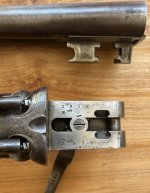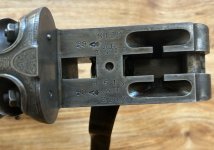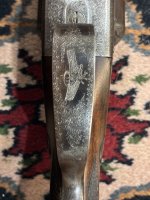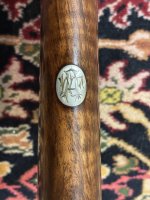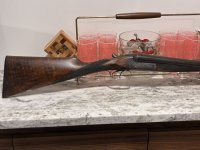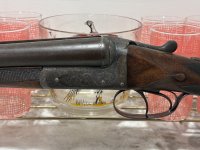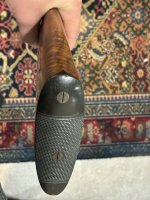Brybenn, I totally agree, it would be good to test the effect of modern barrel boring on patterns and recoil. In inches, what passes for 12 gauge is nominally at .729, but can be as large as .740 (12/1 in British proofs) and still count as a 12. As you point out, 12-gauge barrel diameters can also be constricted (.719, or 13/1; and .710, or 13) and still be chambered for 12-gauge cartridges. For those using the European measurements for 12 gauge, it can range from 18.2 to 18.9 millimetres (18.5 being nominal). This variation presumably has an impact, though it seems no one can tell us just how. We have a pretty good idea of what we think is happening in the chamber and barrel when the primer lights the main powder charge, and the charge with its wadding or shot cup passes through the forcing cone and travels down the barrel. Upon exiting the barrel, science tells us a lot for certain, because of high-speed cameras and the time-honoured method of shooting at paper or sheet metal targets.
Maybe the differences between brands of powder, and between shapes and composition of wadding and plastic cups, are too slight to be meaningful. Add to this hardness of shot and length of forcing cones, and you already have a large set of variables, which may or may not be significant. Then add the variance in bore size above or below the nominal. I have no doubt that the main gun and cartridge manufacturers have tested all of these a great deal and put their statisticians to work on the results. Unfortunately, all we get is the hype from the marketing departments, in their desire for our dollars. If everything marketing folks tell us is true, by now I should be slim, healthy, handsome and prosperous. And a dead-eye shot, to boot. Reality, as they say, is a b___h.
On the subject of narrowing bores, I would be remiss in not mentioning the ‘Vena Contracta’ gun, which was a double gun which had a 12-gauge chamber, a 6-inch forcing cone, and 20-gauge barrel tubes. Possibly first introduced by Joseph Lang, but patented by Horatio F. Phillips in 1893 and built by Webley, it was meant to lighten the barrel weight and, curiously, to reduce recoil, though some describe it as increasing recoil. It was not a commercial success, and I've never seen one. At the time, Phillips was the shooting editor at The Field newspaper. It also goes to show that the discussion about the relationship between bore size and recoil has been going on a long time, without a final conclusion.
I find it interesting that The Field trials of the 1850s and 1860s were done without questioning point-of-aim, as obviously no gunmaker would allow a gun to leave their shop that didn’t shoot where it was pointed, and that the pattern remained centred at 40, 50 and 60 yards and therefore comparable across makers/types. I wonder if modern guns, across brands and models, could claim the same.
I also wonder to myself if, considering our obsession with personal freedom, we would react badly if any given manufacturer of guns, cartridges and chokes would say that we must only use, say, Challenger ammunition of a certain load and shot size, or Federal ammunition of a different shot size, or any other specific combination, etc., if we want to have performance anywhere close to what is claimed. Sort of like optimum octane levels for certain car engines, if you want to match the performance specs. Or, as the apt expression says, ‘your mileage may vary.’ I would add the unspoken part, ‘and you might not like the results.’
Maybe the differences between brands of powder, and between shapes and composition of wadding and plastic cups, are too slight to be meaningful. Add to this hardness of shot and length of forcing cones, and you already have a large set of variables, which may or may not be significant. Then add the variance in bore size above or below the nominal. I have no doubt that the main gun and cartridge manufacturers have tested all of these a great deal and put their statisticians to work on the results. Unfortunately, all we get is the hype from the marketing departments, in their desire for our dollars. If everything marketing folks tell us is true, by now I should be slim, healthy, handsome and prosperous. And a dead-eye shot, to boot. Reality, as they say, is a b___h.
On the subject of narrowing bores, I would be remiss in not mentioning the ‘Vena Contracta’ gun, which was a double gun which had a 12-gauge chamber, a 6-inch forcing cone, and 20-gauge barrel tubes. Possibly first introduced by Joseph Lang, but patented by Horatio F. Phillips in 1893 and built by Webley, it was meant to lighten the barrel weight and, curiously, to reduce recoil, though some describe it as increasing recoil. It was not a commercial success, and I've never seen one. At the time, Phillips was the shooting editor at The Field newspaper. It also goes to show that the discussion about the relationship between bore size and recoil has been going on a long time, without a final conclusion.
I find it interesting that The Field trials of the 1850s and 1860s were done without questioning point-of-aim, as obviously no gunmaker would allow a gun to leave their shop that didn’t shoot where it was pointed, and that the pattern remained centred at 40, 50 and 60 yards and therefore comparable across makers/types. I wonder if modern guns, across brands and models, could claim the same.
I also wonder to myself if, considering our obsession with personal freedom, we would react badly if any given manufacturer of guns, cartridges and chokes would say that we must only use, say, Challenger ammunition of a certain load and shot size, or Federal ammunition of a different shot size, or any other specific combination, etc., if we want to have performance anywhere close to what is claimed. Sort of like optimum octane levels for certain car engines, if you want to match the performance specs. Or, as the apt expression says, ‘your mileage may vary.’ I would add the unspoken part, ‘and you might not like the results.’
Last edited:










































































